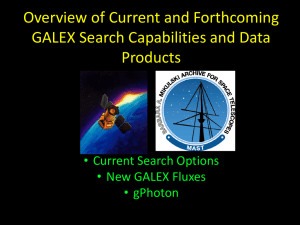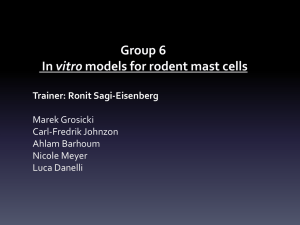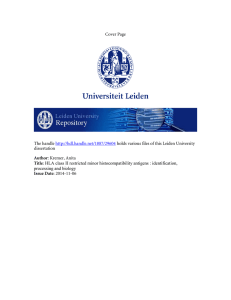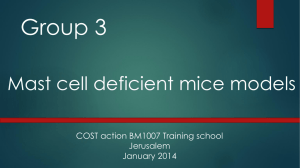12_MAST_Update
advertisement
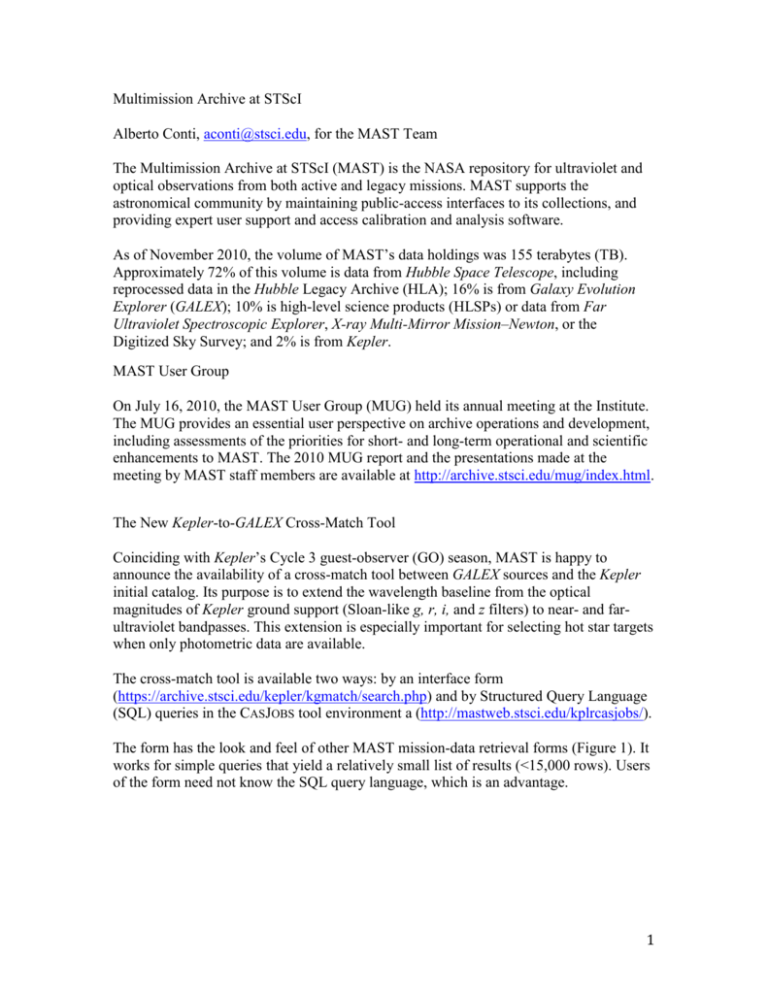
Multimission Archive at STScI Alberto Conti, aconti@stsci.edu, for the MAST Team The Multimission Archive at STScI (MAST) is the NASA repository for ultraviolet and optical observations from both active and legacy missions. MAST supports the astronomical community by maintaining public-access interfaces to its collections, and providing expert user support and access calibration and analysis software. As of November 2010, the volume of MAST’s data holdings was 155 terabytes (TB). Approximately 72% of this volume is data from Hubble Space Telescope, including reprocessed data in the Hubble Legacy Archive (HLA); 16% is from Galaxy Evolution Explorer (GALEX); 10% is high-level science products (HLSPs) or data from Far Ultraviolet Spectroscopic Explorer, X-ray Multi-Mirror Mission–Newton, or the Digitized Sky Survey; and 2% is from Kepler. MAST User Group On July 16, 2010, the MAST User Group (MUG) held its annual meeting at the Institute. The MUG provides an essential user perspective on archive operations and development, including assessments of the priorities for short- and long-term operational and scientific enhancements to MAST. The 2010 MUG report and the presentations made at the meeting by MAST staff members are available at http://archive.stsci.edu/mug/index.html. The New Kepler-to-GALEX Cross-Match Tool Coinciding with Kepler’s Cycle 3 guest-observer (GO) season, MAST is happy to announce the availability of a cross-match tool between GALEX sources and the Kepler initial catalog. Its purpose is to extend the wavelength baseline from the optical magnitudes of Kepler ground support (Sloan-like g, r, i, and z filters) to near- and farultraviolet bandpasses. This extension is especially important for selecting hot star targets when only photometric data are available. The cross-match tool is available two ways: by an interface form (https://archive.stsci.edu/kepler/kgmatch/search.php) and by Structured Query Language (SQL) queries in the CASJOBS tool environment a (http://mastweb.stsci.edu/kplrcasjobs/). The form has the look and feel of other MAST mission-data retrieval forms (Figure 1). It works for simple queries that yield a relatively small list of results (<15,000 rows). Users of the form need not know the SQL query language, which is an advantage. 1 Figure 1. MAST standard interface to the Kepler-GALEX cross-match database. This interface does not require knowledge of SQL, rather it uses a form-based page to allow users to search for objects of interest. Originally, the Department of Physics & Astronomy at the Johns Hopkins University developed CASJOBS for large, batch queries in SQL. MAST adapted CASJOBS—which is useful for sophisticated database queries, and requires knowledge of the SQL query language—for the GALEX and Kepler missions. To ease this requirement, we provide sample queries (Figure 2). Users can easily modify any of the provided samples. A help page devoted to Kepler GO proposers is also provided. CASJOBS remains the recommended way to access the Kepler database for users interested in storing the result 2 of their queries on MAST databases, and for group collaborations. CASJOBS is a powerful tool, allowing nuanced and complicated queries when necessary. Figure 2. CASJOBS interface to the Kepler-GALEX cross-match database. Using this interface, users will be able to formulate sophisticated queries and retrieve specific objects of interest. CASJOBS requires knowledge of SQL. The cross-match tool allows easy access to accurate and complete databases of objects observed by both Kepler and GALEX. Here, “accurate” refers to the performance of our table of one-to-one matches within a search radius of 2.5 arcsec of the position of a Kepler object, and “complete” means we include other possible GALEX matches within a search radius of 5 arcsecs. This approach reflects the fact that an automated cross-match algorithm cannot always unambiguously select the correct match between objects observed by different missions. At times, the best match for an object observed by one mission with objects observed by another mission is not the best match in the reverse direction. Both the form and CASJOBS implementations support uploads of target lists. In the near future, MAST will provide a complementary tool on its GALEX/CASJOBS site to facilitate GALEX-to-Kepler cross matches. 3 GALEX General Release 6 All Sky Survey Data All data for General Release 6 (GR6) of the GALEX All-Sky Imaging Survey (AIS) has been delivered to MAST. The data are available on the MAST/GALEX web site (http://galex.stsci.edu/GR6/ ). A description of the most notable changes between GR6 and the old GR4/5 can be found at http://galex.stsci.edu/doc/gr6_cs.txt. A delivery of GR6 grism data products, expected in January 2011, will complete the GR6 data delivery. The grism data will be available on the News corner and on the table of survey tiles, both located on the MAST/GALEX home page (http://galex.stsci.edu). Availability of New High-Value Sky Regions Observed by GALEX The operations phase of the GALEX mission is now scheduled to end on September 30, 2012. In the intervening time, GALEX has begun to observe sky regions of high science value that have not yet been well observed—or in some cases not observed at all. Starting in November 2010, the GALEX project began delivering the data to MAST in monthly installments which will be made publicly available immediately upon ingest. These deliveries are called “secondary MIS” datasets (Medium Imaging Survey), and can be found within the MIS survey area of the MAST/GALEX web site. First notice of availability will appear on the News corner of the home page. This notice will contain a link to a list of secondary MIS tiles, which will grow over the duration of this observing program. The Hubble Legacy Archive The Hubble Legacy Archive (HLA; http://hla.stsci.edu) provides enhanced data products for many Hubble instruments, as well as an integrated search, quick-look, and retrieval interface for all Hubble data. As of Data Release 4 (March 2010), the HLA includes visitlevel combined data (VLCD) for all science observations with imaging instruments— Advanced Camera for Surveys (ACS), Wide Field Planetary Camera 2 (WFPC2), and Near Infrared Camera and Multi-Object Spectrometer (NICMOS)—that were publicly available through February 2010.1 [Layout: this paragraph is a sidebar] Visit-level combined images are distinguished from the multi-visit deep images (known as Level 3), which combine observations taken in independent Hubble visits with independent guide star acquisitions. Level 3 data may be either deeper (though stacking observations at roughly the same pointing) or wider field (through combining observations at different pointings). There is a more detailed description of visit-level data on the HLA “Getting Started” page (http://hla.stsci.edu/hla_help.html). A visit is defined as a set of Hubble observations taken using the same set of guide stars. A visit may span multiple orbits with guide star reacquisitions. 1 4 Users can identify data of interest by location, target name, instrument, exposure time, and a variety of other selection criteria. A graphical search interface has the ability to display the footprints of each data product. Users can view and retrieve public data through the HLA interface. For proprietary data, a convenient link is provided to the MAST retrieval form. Several movie tutorials are available (http://hla.stsci.edu/hla_movie.html) to help new users understand the capabilities of the HLA interface. The HLA provides three categories of advanced products: source lists, mosaics, and HLSPs. Source lists for VLCD from ACS and WFPC2 were obtained using DAOPHOT and SOURCE EXTRACTOR. In both cases, sources are identified in a combined image using all available filters, which allows easy cross-identification of sources across filters. DAOPHOT source lists are recommended for point sources, while SOURCE EXTRACTOR lists are preferred for extended sources. Mosaics (http://hla.stsci.edu/hla_faq.html#Mosaics1) increase depth and sky coverage by combining data from multiple visits to cover contiguous areas of the sky. Mosaics based on ACS images are currently available for 67 pointings, for a total of 143 single-filter images. In the near future, extending mosaics to include more pointings—and other instruments—is among the highest priorities of the HLA team. The HLA currently incorporates about 4,500 ACS, WFPC2, NICMOS, and Wide Field Camera 3 (WFC3) images provided as HLSPs by independent science teams (http://hla.stsci.edu/hla_faq.html#HLSP). These HLSPs are based on fully processed data—reduced, co-added, cosmic-ray rejected, and mosaicked—and generally represent the best that can be done with Hubble data. HLSPs in the HLA are categorized by project, and can be searched, displayed, and retrieved just as all other HLA products. Planned for early 2011, HLA Data Release 5 will include new categories of data products and substantial improvements in the interface. The footprint interface will be completely revamped, to allow for zooming, panning, and dynamic changes in the products displayed. Advanced WFC3 data products will be introduced, and new mosaics released. Prototype advanced spectral products from Cosmic Origins Spectrograph and Space Telescope Imaging Spectrograph will also be available. Data Release 5 will be announced to all Hubble and MAST users; see http://hla.stsci.edu for updates. 5 Figure 3. Total archived data volume versus the total volume of data distributed over the past 18 months for various MAST missions. Note the heavy use of high-level science products (HLSPs), which are contributed by the community and mainly involve Hubble data. High-Level Science Products The community contributes HLSPs as fully processed images and spectra ready for scientific analysis. We encourage both individuals and teams to archive their scienceready products at MAST. Not only does this move provide a valuable service to the astronomical community, but it also showcases the original research. HLSPs are among the most downloaded products in MAST, second only to Hubble and GALEX data (Figure 3). MAST offers a permanent home for both data and catalogs associated with all HLSPs, and provides a permanent URL to facilitate references in publications. Our bibliographical statistics show that, of the 25 programs with the most associated papers, 72% are also associated with archived HLSPs, and more than half of the top 50 programs are associated with HLSPs. 6 MAST is pleased to announce the recent availability of new HLSPs, which can be accessed through the HLSP web site (http://archive.stsci.edu/hlsp). • The ACS Treasury Survey of the Coma cluster of galaxies is a deep, two-passband imaging survey of the Coma cluster (Abell 1656), which is one of the nearest rich clusters of galaxies. The survey team recently released version 2 of the image data and version 2.1 of the associated catalogs. (http://archive.stsci.edu/prepds/coma/) • NICMOS Legacy Archive Point-Spread Function (PSF) Library (LAPL) provides the highest quality, recalibrated, NICMOS image data for archival coronagraphic science investigations requiring PSF template subtraction. NICMOS coronagraphy probes the closest environments of occulted targets with Hubble’s highest sensitivity at small separations and high contrast. In early 2011, MAST is planning to release data, software, and documentation from Program #11279: A Legacy Archive PSF Library and Circumstellar Environments (LAPLACE). Hubble Multi-Cycle Treasury Program Data Hubble MCT programs provide an opportunity for the community to address high-impact scientific questions requiring observing time on a scale not easily accommodated by the standard time allocation process. MCT programs have no proprietary period, and the three programs launched with Cycle 18 will release their HLSPs to the community in short order via the HLSP page in MAST (http://archive.stsci.edu/hlsp/index.html). See the accompanying articles on CANDELS (H. Ferguson & S. Faber), CLASH (M. Postman), and PHAT (J. Dalcanton). 7
